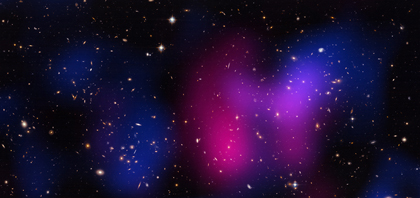Overfed Black Holes Shut Down Galactic Star-Making
A new study has shown that galaxies with the most powerful, active, supermassive black holes at their cores produce fewer stars than galaxies with less active black holes. Researchers compared infrared readings from the Hershel Space Observatory with X-rays streaming from the active central black holes in a survey of 65 galaxies, measured by NASA's Chandra X-ray Observatory.
The Unexpected: Normal Stars
Here's our next installation in our occasional series on the Chandra blog called "The Unexpected." These posts will take a look at some of the biggest surprises (and expected discoveries) made by Chandra so far in its mission. Today's topic is "normal stars," which is what astronomers call stars that are similar to our Sun.
Expected and Detected:
X-ray emission from the outer atmospheres, or coronas, of stars of almost every type: young and old, large and small.
Black Hole Caught Red-handed in a Stellar Homicide
This computer-simulated image shows gas from a star that is ripped apart by tidal forces as it falls into a black hole. Some of the gas also is being ejected at high speeds into space.
A Funny Thing Happened While Waiting for the Next Supernova in M83
William Blair is an astrophysicist and research professor at The Johns Hopkins University in Baltimore, Md. He penned this blog post to help explain the excitement -- and challenges -- involved with getting a handle on the mysterious ULX (ultraluminous X-ray source) he and his colleagues discovered in the spiral galaxy M83.
The spiral galaxy M83, also known as the Southern Pinwheel Galaxy, is an amazing gift of nature. At 15 million light years away, it is actually one of the closer galaxies (only 7-8 times more distant than the Andromeda galaxy), but it appears as almost exactly face-on, giving earthlings a fantastic view of its beautiful spiral arms and active star-forming nucleus. M83 has generated six observed supernovas since 1923, but the last one seen was in 1983. We are overdue for a new supernova!

Gemini Observatory.
Because of all the star formation and supernova activity in M83, we also expect there to be a lot of X-ray binary stars and supernova remnants—the expanding leftovers from old supernovas that stay visible for several tens of thousands of years after the supernova fades. By tying multiwavelength observations of M83 together, my colleagues and I hope to learn a lot about the interplay between the stars and the gas, and how they impact the entire galaxy.
Welcome Home, Shuttle Discovery
This morning, the Space Shuttle Discovery touched down from its final flight – a journey from the Kennedy Space Center in Florida to Washington, DC. Discovery will eventually be on display at the Smithsonian's Udvar-Hazy Center near the Dulles airport.
Chandra's own Roger Brissenden was on hand in Washington, DC, for today's event. Chandra has connections to this event on both the NASA and the Smithsonian sides.
A New View of the Tarantula Nebula
To celebrate its 22nd anniversary in orbit, the Hubble Space Telescope has released a dramatic new image of the star-forming region 30 Doradus, also known as the Tarantula Nebula because its glowing filaments resemble spider legs. A new image from all three of NASA's Great Observatories - Chandra, Hubble, and Spitzer - has also been created to mark the event.
An Interview with Will Dawson
 Will Dawson standing next to the Red Hawk cell spar (currently installed in the Gulf of Mexico).
Will Dawson standing next to the Red Hawk cell spar (currently installed in the Gulf of Mexico).Astronomy can generate a large amount of attention from the public, but the number of working astronomers is smaller than the number of researchers in many other academic fields. So, when people get over their surprise at meeting a real astronomer, they often ask "How did you end up working in this field?". There are many different answers, but an interesting one is provided here by Will Dawson from the University of California, Davis, who kindly explains his career change from engineering to astronomy. We were very satisfied to hear that part of his motivation for this big change came from the publicity generated by the Bullet Cluster in 2006.
Will is the first author of a recent paper describing the discovery of the Musket Ball Cluster.
What field did you work in before astronomy?
After graduating with my bachelor of science degree in Maritime Systems Engineering from Texas A&M at Galveston in 2002, I went to work in the offshore engineering industry at Technip. During my four years with Technip I was primarily involved with the design and analysis of Spars, which are floating offshore oil production platforms (essentially stiffened steel cylinders roughly 90 feet in diameter, 550 feet long and 25,000 tons).
What inspired you to change fields?
Discovery of the Musket Ball Cluster
Using a combination of powerful observatories in space and on the ground, astronomers have observed a violent collision between two galaxy clusters in which so-called normal matter has been wrenched apart from dark matter through a violent collision between two galaxy clusters.
The newly discovered galaxy cluster is called DLSCL J0916.2+2951. It is similar to the Bullet Cluster, the first system in which the separation of dark and normal matter was observed, but with some important differences. The newly discovered system has been nicknamed the "Musket Ball Cluster" because the cluster collision is older and slower than the Bullet Cluster.





